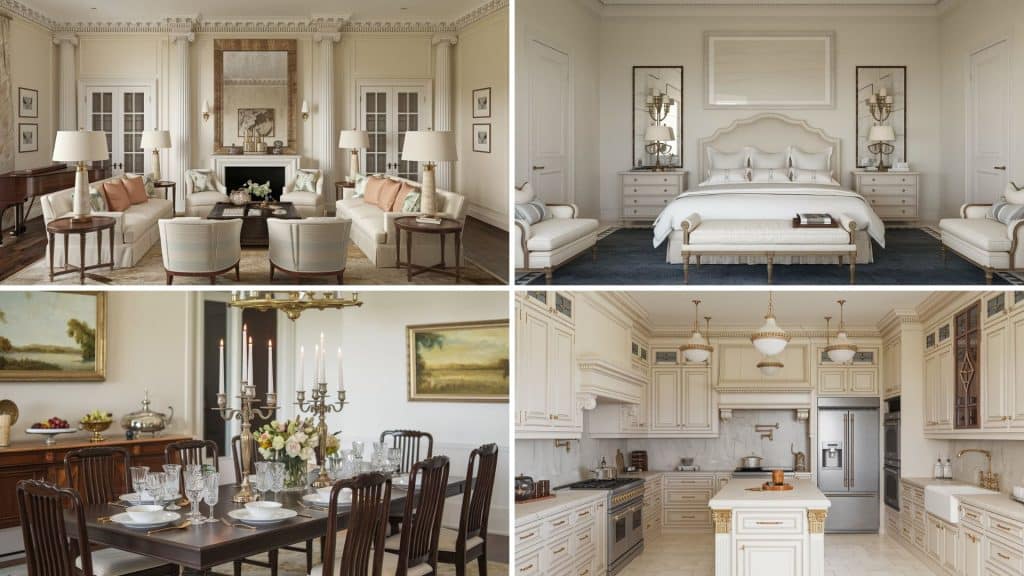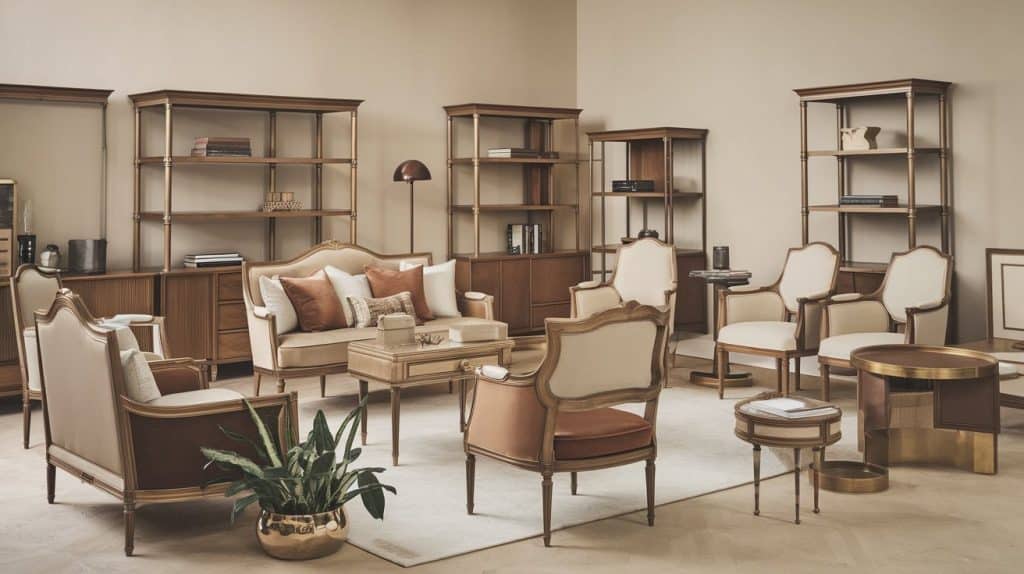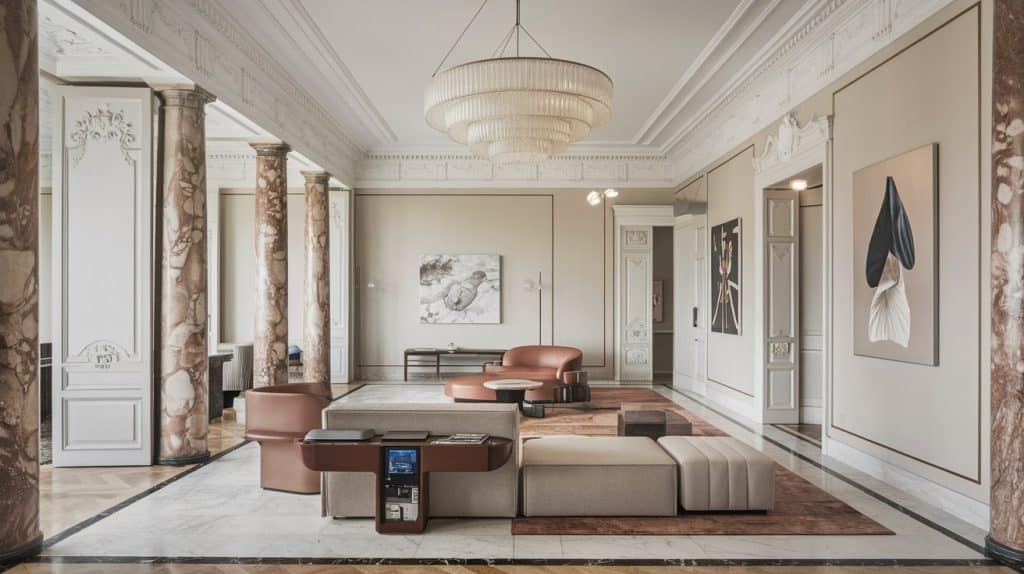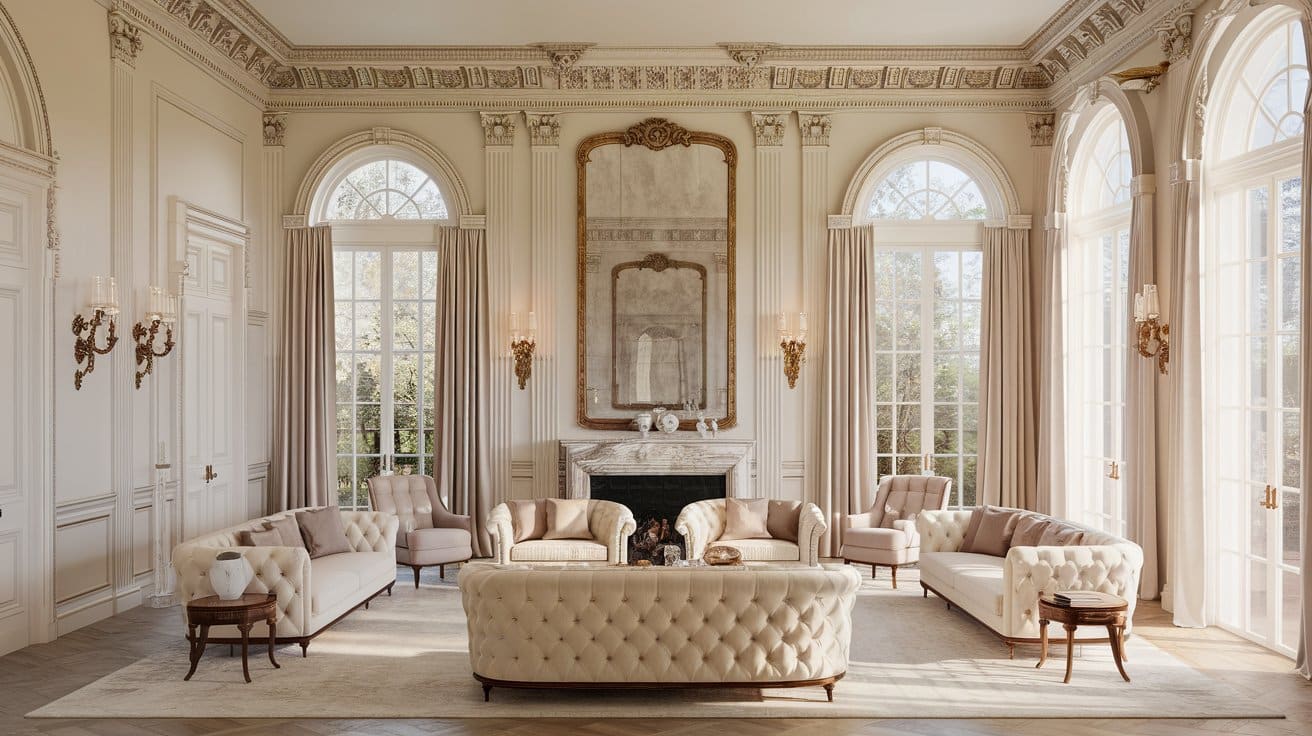Have you ever walked into a room and felt instantly transported to a grand European palace? That’s the power of neoclassical interior design.
I’ve spent years helping homeowners create spaces that feel both timeless and sophisticated. The challenge? Most people think this style is too formal or expensive to pull off in a modern home.
But here’s what I’ve learned: Neoclassical design isn’t about copying a museum. It’s about bringing classical beauty into your everyday life through wise choices and thoughtful details.
In this blog, I’ll show you exactly how to create a neoclassical interior that feels both grand and livable. You’ll learn the key elements, practical tips, and simple steps to make any space something truly special.
What Is Neoclassical Interior Design?
Neoclassical interior design draws inspiration from ancient Greek and Roman art and architecture. This style emerged in the 18th century as a response to the ornate Baroque and Rococo periods that came before it.
The approach focuses on creating spaces that feel calm, orderly, and sophisticated. Unlike other historical styles, neoclassical design emphasizes restraint and balance rather than excessive decoration.
Key aspects include:
- Inspiration from classical antiquity
- Focus on proportion and harmony
- Restrained use of decorative elements
- Suitable for both traditional and contemporary homes
- Can be incorporated through various design choices
Origin of Neoclassical Design
The neoclassical movement began in the mid-1700s across Europe. Archaeological findings at Pompeii and Herculaneum sparked renewed interest in ancient Roman culture. These excavations revealed preserved homes that fascinated designers and architects.
French courts led this revival during King Louis XVI’s reign. Wealthy families moved away from the heavy ornamentation of previous decades. They wanted spaces that reflected education, culture, and refined taste through classical references.
By the 1800s, the style had spread to England and America. Thomas Jefferson famously used these principles in his architectural projects. The movement became associated with democratic values, making it popular for both government buildings and private homes.
Neoclassical Interior Design Key Characteristics
Neoclassical interiors share specific design elements that create their distinctive look. These features work together to achieve the style’s signature balance and sophistication.
1. Symmetry and Proportion
Rooms follow mathematical ratios that please the eye. Furniture placement mirrors itself across central axes. Windows, doors, and architectural features align perfectly. This creates a sense of order and calm throughout the space.
2. Classical Architectural Elements
Subtle architectural elements, such as trim, columns, and moldings, anchor the neoclassical style. Pediments frame doorways and windows throughout the space. Coffered ceilings add visual interest without creating chaos. These details reference ancient temples and public buildings from classical periods.
3. Neutral Color Palette
Whites, creams, and soft grays dominate the scheme. Occasional touches of gold or deep blue provide contrast. Colors remain muted to highlight architectural features. This restrained approach prevents visual chaos.
4. Quality Materials
Marble, stone, and fine woods form the foundation. Silk, linen, and wool cover furniture and windows. Materials feel substantial and well-crafted. Each surface contributes to the overall sense of luxury.
How to Implement Neoclassical Style in Your Home?
Creating a neoclassical interior doesn’t require a complete renovation. You can achieve this look through strategic updates and thoughtful furniture choices.
1. Room-by-Room Approach

1. Living Room: Start with a neutral paint color. Add crown molding and chair rails for architectural interest. Choose a sofa featuring simple shapes and single-color fabric covering. Place matching armchairs opposite each other for symmetry. Install a large mirror with classical framing above the fireplace. Use table lamps with column-style bases on side tables.
2. Bedroom: Select a headboard with simple geometric shapes or upholstered panels. Use crisp white linens with minimal patterns. Add a bench at the foot of the bed in matching fabric. Choose nightstands with straight lines and brass hardware. Install sconces on either side of the bed for balanced lighting.
3. Dining Room: Center a large rectangular table in dark wood like mahogany or walnut. Surround it with chairs featuring straight backs and neutral cushions. Hang a crystal or brass chandelier directly above the table. Add a sideboard along one wall for storage and display. Use formal place settings with classic white china.
4. Kitchen: Install white or cream cabinets with raised panel doors. Choose marble or quartz countertops in neutral tones. Add a subway tile backsplash in white or cream. Select brass or bronze hardware for cabinets and faucets. Use pendant lights with classical shapes over the island.
2. Architectural Upgrades

Adding molding and trim throughout your home creates instant classical appeal. These structural elements provide the foundation for authentic neoclassical style without major construction work.
Focus on upgrades that make the biggest visual impact first. Start with crown molding in the main living areas, then add chair rails and wainscoting where appropriate.
Key upgrades include:
- Crown molding in all main living spaces
- Chair rails for dining rooms and hallways
- Wainscoting on the lower wall sections
- Wider doorway trim with classical profiles
- Solid wood doors with raised panels
- Columns or pilasters in open floor plans
3. Choosing the Right Furniture

Select pieces with straight, clean lines instead of curved details. Solid wood construction provides the quality this style demands. Look for furniture with minimal ornamentation and classic proportions.
Choose upholstery in solid, muted tones that complement your space. Skip busy patterns and bright colors that compete with architectural elements. This restrained approach allows architectural features to take center stage.
Metal accents work best in warm finishes such as brass and bronze instead of cool silver tones. Hardware on cabinets, lamp bases, and decorative objects should maintain this consistent warm metallic theme throughout your space.
Making Neoclassical Design Work for Modern Life

The key to successful neoclassical design lies in mixing traditional elements with contemporary comfort. You don’t need to live in a museum to appreciate classical beauty in your daily life.
Start by choosing one or two classical features as your focal points. Then surround these pieces with modern conveniences that support your lifestyle. The goal is to create harmony between old and new without compromising function.
Key strategies include:
- Choose classical focal points like crown molding or marble surfaces
- Hide modern technology inside cabinets with classical detailing
- Select electronics with clean lines and neutral finishes
- Prioritize comfort in seating while maintaining classical proportions
- Use durable fabrics that look luxurious but handle daily use
- Blend modern appliances by choosing models with simple, clean designs
How to Create Your First Neoclassical Living Space?
Beginning a neoclassical design project can feel overwhelming with so many elements to consider. The smart approach is starting small and building your style gradually over time.
Focus on one room first, preferably your living room or dining room, where guests will notice the changes most. These spaces offer the best opportunity to showcase classical elements without disrupting your daily routines.
Start with these beginner-friendly steps:
- Paint walls in muted tones such as ivory, light taupe, or off-white
- Add one piece of classical furniture, like a console table or mirror
- Install simple crown molding in your chosen room
- Replace basic light fixtures with classical-inspired designs
- Introduce marble or stone accessories through vases or decorative objects
- Choose one area rug with geometric patterns or solid neutral tones
Avoid These Neoclassical Design Mistakes
Many homeowners make common errors when attempting neoclassical design. These mistakes can make your space feel overdone or inauthentic rather than sophisticated and balanced.
- Mixing too many different periods or styles – Stick to one classical approach rather than combining Greek, Roman, and French elements in the same space.
- Using overly ornate furniture – Choose pieces with clean lines instead of heavily decorated items that compete with architectural details.
- Choosing bright or bold colors – Maintain the neutral palette that defines this style rather than introducing jarring color contrasts.
- Installing fake classical elements – Invest in quality materials rather than plastic columns or foam molding that look obviously artificial.
- Overcrowding rooms with accessories – Less is more in neoclassical design; allow each piece to have visual breathing room.
Conclusion
After covering all these, I hope you feel confident about starting your neoclassical design project. This style has the power to make any home feel more refined and timeless.
The beauty of neoclassical design lies in its flexibility. You can adapt these principles to fit your budget, space, and personal preferences while still achieving that classical sophistication.
Remember that creating a neoclassical interior is a process, not a race. Take your time selecting quality pieces and making thoughtful changes that will serve you for years to come.
Ready to alter your space? Start with one simple change from this blog and watch how it impacts your entire room. I’d love to hear about your neoclassical design experience – share your thoughts in the comments below!
Frequently Asked Questions
What Are the Main Themes of Neoclassicism?
Neoclassicism focuses on three core themes: rationalism through logical thinking, order through structured design principles, and classicism by drawing inspiration from ancient Greek and Roman art.
What Reflects Neoclassical Style?
Neoclassical style reflects a “back to basics” approach in design. It emphasizes clean lines, symmetry, subdued colors, and rational design principles inspired by classical antiquity.
How Do You Recognize Neoclassical Interiors?
Look for neutral color palettes, geometric furniture shapes, classical architectural details like columns or molding, marble surfaces, and balanced, symmetrical room arrangements throughout the space.

